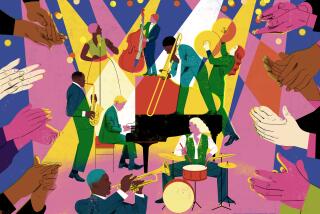ALBUM REVIEWS /JAZZ
- Share via
JOE LOVANO “Joe Lovano Quartets Live at the Village Vanguard” *** Blue Note
Tenor saxophonist Lovano was probably the most honored performer in jazz last year. His MVP season included winning Down Beat magazine’s triple crown achievement of jazz musician of the year, most popular tenor saxophonist and jazz album of the year.
Despite all the praise, however, Lovano has been a musically elusive artist, exceptionally good at almost anything he tries, but without the clearly focused creative identity necessary to give a performer the extra step up to hall of fame potential.
He’s not far away, however, and the two CDs in this new release are demonstrations in just how good he can be, regardless of the music’s style. Recorded live in March 1994 and January 1995 with two very different ensembles, they showcase contrasting aspects of Lovano’s improvisational strengths.
The first, with Tom Harrell, trumpet, Anthony Cox, bass, and Billy Hart, drums, is based (with one or two exceptions) upon a program of free-jazz-oriented tunes. Not always known for his envelope-stretching abilities, Lovano plays with a consistent edge of curiosity, accomplishing the difficult task of creating his own improvisational geography while surrounded by wide-open, undefined aural settings. Harrell, as usual, offers one gripping solo after another.
The second CD, with the state-of-the-art rhythm team of Mulgrew Miller, piano, Christian McBride, bass, and Lewis Nash, drums, is a straight-ahead blowing session on tunes by John Coltrane, Thelonious Monk, Miles Davis, etc. Lovano is once again impressive, often finding places to insert bits and pieces of freestyle phrasing in more structured works such as “Lonnie’s Lament” and “26-2” (Coltrane) and “Little Willie Leaps” (Davis).
Interestingly, the pure, expressive emotions that characterize the first recording rarely break through in this set. But what does emerge is never less than world-class--clear evidence that Lovano, when he brings his chameleon-like styles into focus, fully justifies the growing view of him as an important, world-class jazz talent. Albums are rated on a scale of one star (poor), two stars (fair), three stars (good, recommended), four stars (excellent).
More to Read
The biggest entertainment stories
Get our big stories about Hollywood, film, television, music, arts, culture and more right in your inbox as soon as they publish.
You may occasionally receive promotional content from the Los Angeles Times.









